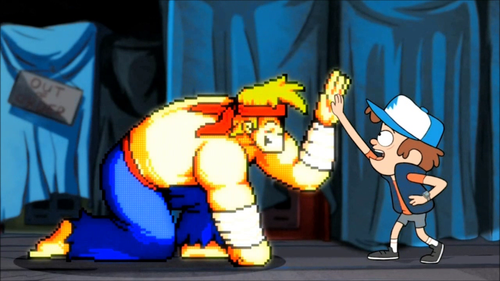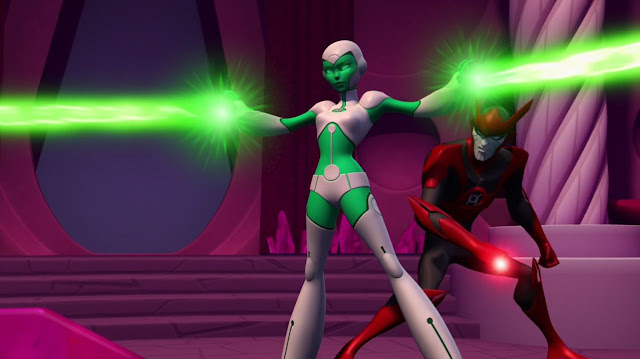 |
| "I rocked a ginormous beard before everybody in Williamsburg started doing it. Whatever," says Alvin the Treacherous, the first hipster. |
On Transformers Prime, the Frank Welker-voiced Megatron's latest obsession is the Star Saber, an Excalibur-like sword from Cybertron that's stuck in a giant rock on Earth and can only be removed by Optimus Prime or any Cybertronian who's a Prime. While Megatron tries to get his dibs on the relic before Optimus can, Smokescreen has gotten into hot water with the Autobots for revealing his robot mode to scare the shit out of a human he argued with when the driver experienced road rage over Smokescreen's reckless driving. Too bad Google's driverless cars can't lash out at hostile and psychotic drivers and transform into intimidating robots to scare them away like Smokescreen does in "Legacy."
 |
| (Photo source: Comics Online) |
The decision to keep the duo's pranks off-screen robs "Legacy" of some much-needed fun. It also keeps the show from making a grown-up and complex point about pranks, like how some pranks can be harmful and not worth staging, while other pranks can be beneficial and cathartic for the wronged prankster. A cop-out like that is why Transformers Prime is merely an okay cartoon, while Gravity Falls, which took a subversive "Revenge is underrated--that felt awesome!" stance in "Irrational Treasure" while also conveying how revenge can go too far in "Fight Fighters," and Regular Show, which did both those things in "Prankless," are great cartoons.
***
Speaking of bullies, Kaijudo: Rise of the Duel Masters has distinguished itself for addressing the timely issue of bullying and the difficulties of having to put up with racist classmates (it's ironic how Kaijudo airs on a channel that recently indulged in a little racism at Comic-Con) and somehow seamlessly incorporating those problems into an escapist saga for kids that's mainly about monster battles. The show revisits bullying in "Night Moves," but this time, it focuses on girls who do the bullying--in this case, mean girls from Allie's circle of rich middle school friends who mistreat Lucy (Alanna Ubach, a.k.a. the It's Always Sunny in Philadelphia crack whore who memorably exclaimed, "Shut up, baby dick!"), an overalls-clad classmate from the impoverished side of town.
There's an interesting moment early on in "Night Moves" where Allie laughs along with her classmates at the insults directed at Lucy from mean girl Portia (also Ubach), while an upset Ray and Gabe, who are no strangers to being pushed around for being different, see no humor in Portia's remarks. Allie realizes her mistake, so in an attempt to get Portia and Lucy to make peace with each other, she invites Lucy to a sleepover with Portia and another friend, Maribel (Grey DeLisle), at her and her wealthy dad's beachside house. But the sleepover doesn't go smoothly, and the night gets worse when a ghost-story prank Ray and Gabe attempt to subject the four girls to--with the help of a creature from the Darkness Civilization--attracts the attention of evil Duelist Alakshmi Verma (also DeLisle) and her latest monstrous sidekick.
Written by Ross Berger, "Night Moves" makes some dead-on observations about the cruelty of kids at a certain age where they're not quite teens yet. Because Ray and Gabe are middle-schoolers and their hormones haven't gone crazy yet, their way of relating to girls is to scare them instead of getting them to make out with them. Another nice touch is the way that the mean girls' treatment of Lucy is more class-related than race-related (although it's implied that Portia despises immigrants as well). The fact that Maribel is a rich Latina who's mistreating a poorer Latina brings class into this story of bullying and shows that wealth can sometimes be more complicated than race. A lesser cartoon would have made the mean girls all-white or ended the episode with Allie lecturing them about their cruelty. Because Kaijudo is a bit smarter than that, "Night Moves" ends with Allie wordlessly ditching the mean girls and dressing like Lucy as a show of solidarity. And because the dialogue on Kaijudo is remarkably never overwritten (aside from the occasional bit of exposition about kaiju), the John DiMaggio-voiced skater dude who compliments Allie and her new friend on their less ritzy threads dismisses Portia and Maribel with a great episode-closing line: "Pshaw."





















